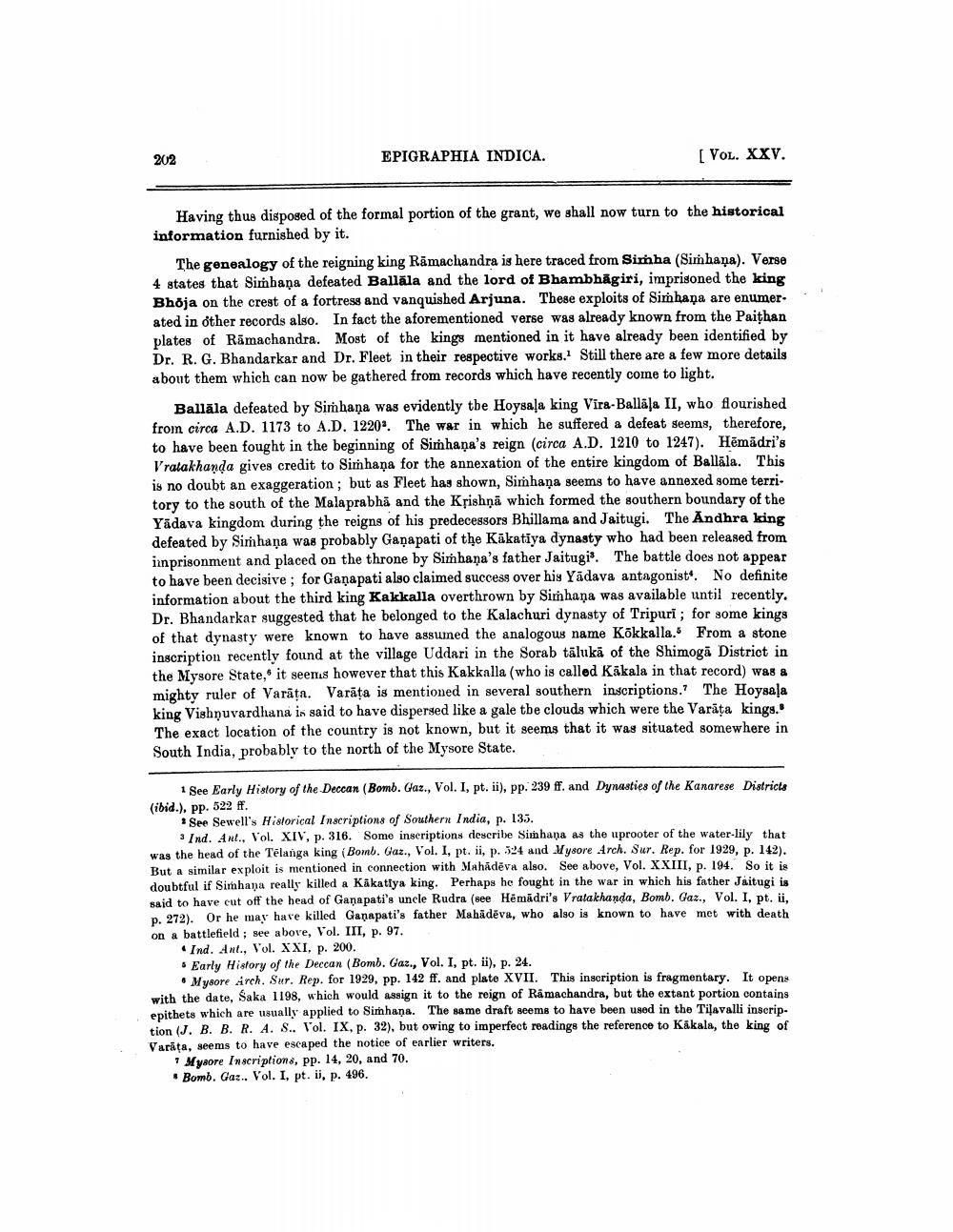________________
202
EPIGRAPHIA INDICA.
[ VOL. XXV.
Having thus disposed of the formal portion of the grant, we shall now turn to the historical information furnished by it.
The genealogy of the reigning king Ramachandra is here traced from Simha (Simhana). Verse 4 states that Simbaņa defeated Balläla and the lord of Bhambhāgiri, imprisoned the king Bhoja on the crest of a fortress and vanquished Arjuna. These exploits of Simhaņa are enumerated in other records also. In fact the aforementioned verse was already known from the Paithan plates of Ramachandra. Most of the kings mentioned in it have already been identified by Dr. R. G. Bhandarkar and Dr. Fleet in their respective works. Still there are a few more details about them which can now be gathered from records which have recently come to light.
Balläla defeated by Simhana was evidently the Hoysala king Vira-Ballala II, who flourished from circa A.D. 1173 to A.D. 1220The war in which he suffered a defeat seems, therefore, to have been fought in the beginning of Simhana's reign (circa A.D. 1210 to 1247). Hēmādri's Vratakhanda gives credit to Simhaņa for the annexation of the entire kingdom of Ballāla. This is no doubt an exaggeration; but as Fleet has shown, Simhaņa seems to have annexed some territory to the south of the Malaprabhā and the Kţishņā which formed the southern boundary of the Yadava kingdom during the reigns of his predecessors Bhillama and Jaitugi. The Andhra king defeated by Simhana was probably Ganapati of the Kākatiya dynasty who had been released from imprisonment and placed on the throne by Simhana's father Jaitugi®. The battle does not appear to have been decisive; for Ganapati also claimed success over his Yadava antagonist. No definite information about the third king Kakkalla overthrown by Simhana was available until recently. Dr. Bhandarkar suggested that he belonged to the Kalachuri dynasty of Tripuri; for some kings of that dynasty were known to have assumed the analogous name Kokkalla. From a stone inscription recently found at the village Uddari in the Sorab tälukā of the Shimoga District in the Mysore State, it seems however that this Kakkalla (who is called Käkala in that record) was a mighty ruler of Varăța. Varāta is mentioned in several southern inscriptions.? The Hoysala king Vishnuvardhana is said to have dispersed like a gale the clouds which were the Varāta kings. The exact location of the country is not known, but it seems that it was situated somewhere in South India, probably to the north of the Mysore State.
1 See Early History of the Deccan (Bomb. Gaz., Vol. I, pt. ii), pp. 239 ff. and Dynasties of the Kanarese Districts (ibid.), pp. 522 ff.
* See Sewell's Historical Inscriptions of Southern India, p. 135.
Ind. Ant., Vol. XIV, p. 316. Some inscriptions describe Simhana as the uprooter of the water-lily that was the head of the Tēlanga king (Bomb. Gaz., Vol. I, pt. ii, p. 524 and Uysore Arch. Sur. Rep. for 1929, p. 142). But a similar exploit is mentioned in connection with Mahadeva also. See above, Vol. XXIII, p. 194. So it is doubtful if Simhaņa really killed a Kakatiya king. Perhaps he fought in the war in which his father Jaitugi is said to have cut off the head of Ganapati's uncle Rudra (see Hemadri's Vratakhanda, Bomb. Gaz., Vol. I, pt. ii. p. 272). Or he may have killed Ganapati's father Mahadeva, who also is known to have met with death on a battlefield ; see above, Vol. III, p. 97.
Ind. Ant., Vol. XXI, p. 200. . Early History of the Deccan (Bomb. Gaz., Vol. I, pt. ii), p. 24.
• Mysore arch. Sur. Rep. for 1929, pp. 142 ff. and plate XVII. This inscription is fragmentary. It opens with the date, Saka 1198, which would assign it to the reign of Ramachandra, but the extant portion oontains epithets which are usually applied to Simhans. The same draft seems to have been used in the Tilavalli inscription (J. B. B. R. A. S.. Vol. IX, p. 32), but owing to imperfect readings the reference to Kakala, the king of Varkta, seems to have escaped the notice of earlier writers.
Myaore Inscriptions, pp. 14, 20, and 70. • Bomb. Gaz.. Vol. I, pt. ii, p. 496.




